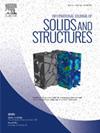一种新型多功能轴对称试件,用于粘接接头的混合模态I/II表征
IF 3.4
3区 工程技术
Q1 MECHANICS
International Journal of Solids and Structures
Pub Date : 2025-04-23
DOI:10.1016/j.ijsolstr.2025.113377
引用次数: 0
摘要
粘接接头在I/II混合模式载荷条件下的断裂韧性表征对于许多实际应用至关重要。具体来说,了解节点在混合荷载作用下的行为对于建立可靠的数值模型至关重要。本研究提出了一种新的试样测试方法来表征模态混合。与文献中现有的方法不同,所提出的程序依赖于易于制造的轴对称样品和简单的测试技术。与已有研究结果的对比表明,该方法可以有效地用于纯I型和II型断裂韧性的表征。然后,这些数据可用于关节的内聚区模型(CZM)。实验验证表明,该模型能较准确地预测I/II混合加载条件下的节点行为。因此,该方法大大简化了在一般负载条件下充分表征粘合剂所需的测试程序。此外,所提出的试样设计可以在不同的试验机上用于不同应变速率下的表征。本文章由计算机程序翻译,如有差异,请以英文原文为准。
A novel versatile axisymmetric specimen for mixed-mode I/II characterization of adhesively bonded joints
The characterization of the fracture toughness of adhesive joints under mixed-mode I/II loading conditions is crucial for many real-world applications. Specifically, understanding the behaviour of joints under mixed loads is essential for the development of reliable numerical models. This study presents a novel specimen testing methodology for characterizing mode mixity. Unlike existing methods in the literature, the proposed procedure relies on easily manufacturable axisymmetric specimens and simple testing techniques. Comparisons with existing studies demonstrate that the method can be effectively applied for the characterization of both pure mode I and mode II fracture toughness. These data can then be used to inform a Cohesive Zone Model (CZM) of the joint. Experimental validation shows that the model can accurately predict the joint’s behaviour under mixed-mode I/II loading conditions. Thus, this methodology significantly simplifies the testing procedures required to fully characterize an adhesive under generic loading conditions. Moreover, the proposed specimen design can be used on different testing machines for the characterization at different strain rates.
求助全文
通过发布文献求助,成功后即可免费获取论文全文。
去求助
来源期刊
CiteScore
6.70
自引率
8.30%
发文量
405
审稿时长
70 days
期刊介绍:
The International Journal of Solids and Structures has as its objective the publication and dissemination of original research in Mechanics of Solids and Structures as a field of Applied Science and Engineering. It fosters thus the exchange of ideas among workers in different parts of the world and also among workers who emphasize different aspects of the foundations and applications of the field.
Standing as it does at the cross-roads of Materials Science, Life Sciences, Mathematics, Physics and Engineering Design, the Mechanics of Solids and Structures is experiencing considerable growth as a result of recent technological advances. The Journal, by providing an international medium of communication, is encouraging this growth and is encompassing all aspects of the field from the more classical problems of structural analysis to mechanics of solids continually interacting with other media and including fracture, flow, wave propagation, heat transfer, thermal effects in solids, optimum design methods, model analysis, structural topology and numerical techniques. Interest extends to both inorganic and organic solids and structures.

 求助内容:
求助内容: 应助结果提醒方式:
应助结果提醒方式:


